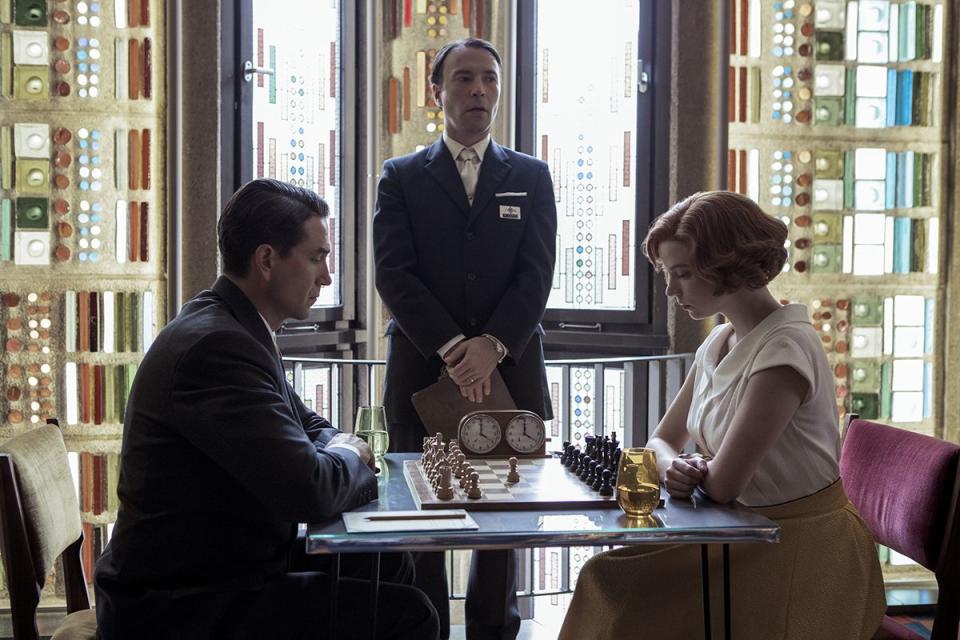Is The Queen’s Gambit Based on a True Story?

There have been plenty of superstars in the world of chess. From Bobby Fischer to Garry Kasparov and Magnus Carlsen, players have made headlines around the world and found the kind of celebrity that’s often reserved for movie stars or sports champions.
Beth Harmon is a little different. That might be because Harmon, the protagonist of The Queen’s Gambit, the glamorous, gritty, and absolutely captivating Netflix series—which has been nominated for 18 Emmy Awards, including Outstanding Limited or Anthology Series and Outstanding Lead Actress in a Limited or Anthology Series or Movie for star Anya Taylor-Joy—is a fictional character. She was dreamed up by author Walter Tevis for his 1983 book of the same name. But that doesn’t mean that everything you see on the series is entirely imaginary. What's real in the world of The Queen's Gambit? We found out.
Beth Harmon is a fictional character.

The character, played by Anya Taylor-Joy, was created by Tevis for his book, and there weren’t many world-famous female players in the spotlight at the time to inspire him. The Hungarian chess champion Judit Polgár could have done the trick, but she didn’t become a Grandmaster until 1991. (Her sister, the Susan Polgar, received the title the same year.) And when it comes to Beth’s extracurricular activities—namely her struggled with addiction—insiders doubt that any chess champion could manage such struggles while playing at such a high level. “I can’t tell you I’ve ever heard of a chess player performing on Valium,” chess champion Jennifer Shahade told the New York Times.
But the series used insider knowledge.

“I produced the movie Searching for Bobby Fischer, and one of the people I met in the course of making that was Bruce Pandolfini, who’s a chess Grandmaster,” says William Horberg, an executive producer on the series. “The character Ben Kingsley plays in that movie is based on him. Pandolfini was the first guy I called when [writer and director] Scott Frank and I finally realized we were going to revive this project. I brought him to lunch, and it turned out he had been hired by the publisher to be Walter Tevis’s consultant on the book. It was a real moment of kismet to find that he had a connection to the author and original material; he even came up with the title.”
So, Pandolfini taught members of the Gambit cast how to play the game—“he’s the godfather of chess and I deeply adore him,” series star Anya Taylor-Joy tells T&C—but that isn’t all he offered. According to Horberg, Pandolfini also lent some real-life expertise to the series’s depiction of the world of high-level chess in the mid-20th century. “He lived this era, he knew Bobby Fischer, and he was involved in the famous 1972 Fischer-Spassky broadcast from Reykjavik as a commentator,” Horberg says.
And it had more than one expert.

Pandolfini also made some integral introductions for the series to make its story seem as real as possible. “Through Bruce, we got introduced to Garry Kasparov, who’s probably the greatest chess player of all time,” Holberg says. “The beautiful thing about Garry is that not only did he consult with us about the actual chess in the show, but he was the person who has an autobiography that mimics the main character.”
Indeed, Kasparov came of age roughly around the same time as the Harmon character and was also a child prodigy when she was coming to prominence. “He had so much to give on a personal level about what it’s like to be seven or 10 years old and a genius, taken out of regular circumstances and having your life changed—family dynamics, the KGB, going to tournaments,” Holberg says. “That was gold for us.”
Kasparov wasn’t sure TV could accurately depict the real feeling of high stakes chess but found himself convinced. “Trust me,” he told the New York Times. “This is as close as one can have it.”
The actors used real chess players for inspiration.

Actor Harry Melling, who plays Kentucky chess champion Harry Beltik in the series, notes that while the characters on the show are fictional, it isn’t hard to see where the novel and series found inspiration in real life. “[Tevis] obviously used characters like Bobby Fischer and other well-known chess figures to help the story along, but it is a piece of fiction,” he says. “Walter’s novel and Scott’s adaptation tap into that history and make you think it must be a true story because it feels so real.”
Still, some TV magic was required.

While Beth’s travels take her from her hometown of Lexington, Kentucky to New York, Paris, Mexico City, and even Moscow, the series did the bulk of its European shooting in a city that never appears on film as itself: Berlin. Holberg says, “Berlin was counterintuitive because there’s not a moment in the story that’s set there, but we ended up using the city for all of these other places that Beth goes. When you think about it, Berlin was destroyed and then rebuilt in the 1950s and 60s, so it’s a tremendous canvas of a wide variety of architecture rooted in that post-war, Modernist period. The fact that we have an Aztec palace in Mexico City and a 1960s Las Vegas casino was such a gift.”
You Might Also Like


